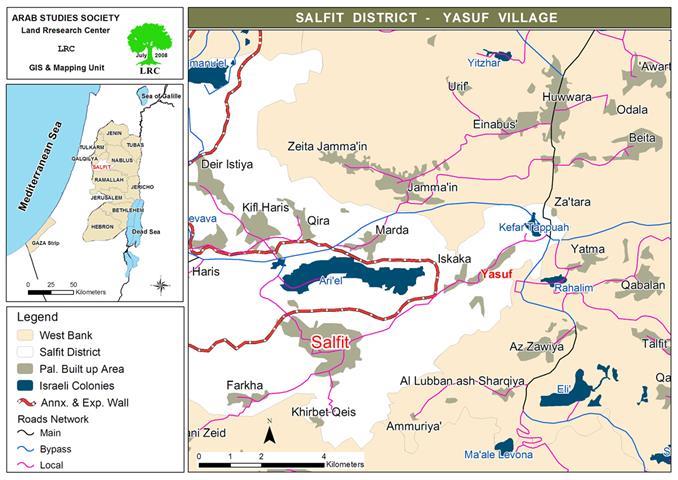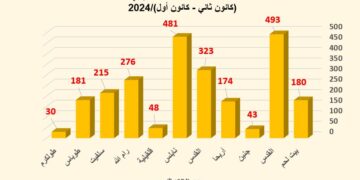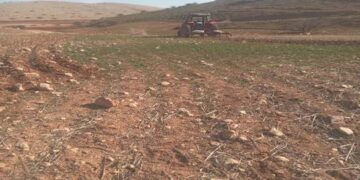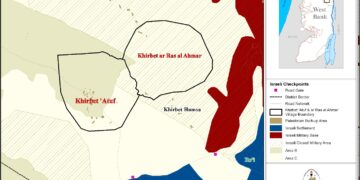The residents of the villages of Yasouf and Iskaka are suffering from an increased presence of Israeli colonist shepherds from the nearby colony of Tapuh on their lands. This phenomenon has been on the increase for the past 5 years as colonist shepherds let their sheep roam freely in the areas of Za’atara, Jabal Al Suwweid in addition to the area of Al Tien Al Shamal all of which are located north and northwest of the village of Yasuf. The targeted areas are filled with olive tress that are at least 70 years old. Colonists target these trees through allowing their sheep to eat their leaves in addition to cutting down a large number of them using sharp objects as seen by a number of eye witnesses from the village of Yasuf. Furthermore, Israeli occupation forces actively prevent Palestinian farmers from reaching their lands that are located in the vicinity of the colony which encouraged the colonists to use their lands as farm land for their sheep.
In addition, the colonists living in the new colonial outpost of Rahaleem B, located between the villages of Yasuf and Iskaka, are becoming a source of grave danger on the farmers as indicated by one of the Palestinian farmers to the Land Research Center’s field worker: ' The colonists release a large number of their sheep in the immediate vicinity of the outpost which led to the destruction of our crops as well as the wheat we grow there. '
Also, the colonists prevent Palestinian farmers from reaching their land located near the outpost since its establishment in 2002. This prevention has led, in turn, to depriving a large number of farmers from their only source of income.
Yasuf’s village council expressed the following to the field worker: ' Our farmers have tried on a number of occasions to file a number of complaints against the colonists in the Israeli Police headquarter in the colony of Ariel. However, they were always turned away under the pretext that they don’t have the necessary permits to enter the colony. In addition, the Police is very reluctant to pursue any investigation in the filed complaints. This fact has led a large number of farmers to feel desperate and hopeless. '
Throughout the years of the occupation, Israeli occupation forces, the Israeli Border Police in addition to the Nature Police have been actively preventing the Palestinian farmers to enter their grazing areas under the pretext that the “sheep are actively destroying the plant biodiversity” and that it is their duty to protect nature. Using similar pretexts, Israeli occupation forces were successful in displacing the Bedouins from their dwellings, closing down the grazing areas by military orders as well as confiscating the lands. The same policy is NOT implemented vis-à-vis the colonists and their sheep that are currently present in the Natural Reserve and Militarily Closed Areas. !!!! The relevant Israeli authorities do not prevent the colonists and their sheep from “destroying natural biodiversity.” These authorities only intervene in providing protection for the colonists in case Palestinian landowners try to push them out of their lands.
General Information about the Village of Yasuf:
The village of Yasuf is located 7 kilometers north east of the city of Salfeet. According to the 2007 statistics, there are about 2000 Palestinians living in the village in 260 families. About 87% of its residents depend on agriculture and entrepreneurship as the main sources of income. The remaining population work in the public realm.
The total area of the village is about 8550 dunums of which 1000 dunums constitute the buildup area of the village. About 300 dunums are used for colonial purposes including the establishment of the colony of Tapuh in 1982 north of the village on 200 dunums. The other 100 dunums are occupied by the colonial outpost of Rahalim B (located south of the village) and the colony of New Tapuh (located east of the village).
It is noteworthy in this regard that the residents of the village are suffering on a daily basis from these colonies as illustrated by the colonialists preventing villagers from using agricultural roads to access their agricultural land as well as by the closure of these roads by dirt barriers. That is in addition to the uprooting of more than 1000 olive trees in the vicinity of the colony of Tapuh as well as the deliberate release of large numbers of wild pigs in the village which caused the destruction of a large number of farm land in it. Furthermore, it is becoming customary that colonists would dump waste water into the agricultural land of the village which has caused many cases of disease in the village, in addition to the destruction of its agricultural land.
In addition to the above, occupation authorities have confiscated some 80 dunums in the seventies of the last century to establish a number of bypass roads. The most prominent of these roads is Road No. 60, a 3 kilometers of which passes through the villages’ eastern lands. Another bypass road is Road 505 (a.k.a. Trans Samaria) which crosses the villages’ northern lands over a distance of 2 kilometers. The construction of these two roads has led to the uprooting of more than 1200 olive trees.
Moreover, Israeli occupation authorities confiscated in the year 2004 about 300 dunums from the villages’ northern lands on the junction connecting Road 60 and Road 505 (a.k.a. Za’atara junction) for the purpose of the establishment of a checkpoint that separates between the middle and northern parts of the West Bank. This checkpoint is notoriously known for the suffering it causes for Palestinians in its vicinity and those who try to access the different parts of the West Bank through it.
Furthermore, Israeli occupation forces have closed down all of the main entrances and exists of the village between 2002 and 2005. They have also placed a gate on the village’s northern entrance which connects it to Road 505. The gate has caused great suffering for the people of the village and neighboring villages and led to difficulties of movement for the villages’ inhabitants, which in turn led to economic, social and psychological problems suffered by the inhabitants.
Prepared by:
The Land Research Center
LRC















